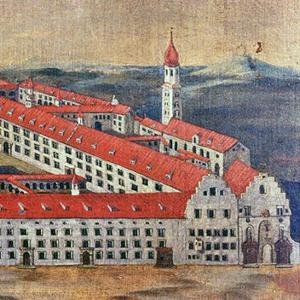
The Jesuit College in Ingolstadt. | © Stadtarchiv Ingolstadt
Petrus Canisius, Claudius Jajus and Alfons Salmeron were the first Jesuits to arrive in Ingolstadt. They reached the town on 13 November 1549, equipped with instructions issued by the founder of their Order, Ignatius of Loyola. At this point, the University’s position was critical, and staffing levels in the Faculty of Theology had reached their lowest ebb, at a time when the political leaders of the territory were in dire need of qualified parish clergy to realize their goal of keeping their territory Catholic.Wilhelm IV wanted to institute a thoroughgoing reform of the study of theology and the University as a whole, and hoped that this would be possible with the help of the new Jesuit professors.On 16 November 1549 Petrus Canisius gave his inaugural lecture at Ingolstadt University. He had not only been appointed Professor, he also served as Rector, Vice-Chancellor and University Chaplain. The Jesuit contribution to the education of theologians in Ingolstadt also stimulated the evolution of the Societas Jesu into the intellectual driving force behind the Counter-Reformation.In 1552 the Jesuits had to leave Ingolstadt for a time, owing to delays in the construction of a college for them. The deficits in the training of new priests continued, so Duke Albrecht V recalled them, promising that the new College would be erected with all possible speed. He also reserved two professorships in Theology at the University for members of the Order, and a third would subsequently be added. In 1558 the first Jesuit was appointed to a Chair in the Faculty of Arts, and by 1585 all professorships in Arts Faculty were held by Jesuits. In 1675, the Chair of Canon Law, which was formally part of the Faculty of Jurisprudence, was also reserved for the Order.The Society of Jesus supplied the University in Ingolstadt with many outstanding intellectuals. Among the first were Jakob Gretser, one of the leading Catholic theologians of the 16th century, and Christoph Scheiner, who first described sunspots.Hostility to the Jesuits became evident early on, but their position became untenable during the 18th century. Tensions between the various Christian denominations had lessened and educational reformers in state bureaucracies now regarded the Order as an obstacle to their plans. Modernizing tendencies began to alter the universities in ways that were prejudicial to the hegemony of the Order. A Papal Bull issued on 21 July 1773 finally dissolved the Society of Jesus, giving secular reformers a free hand.
